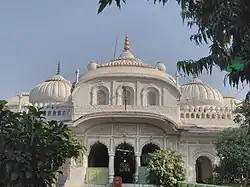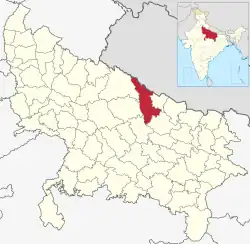Bahraich district
Bahraich district is one of the districts of Uttar Pradesh state of India, and Bahraich town is the district headquarters. Bahraich District is a part of Devipatan Division.
Bahraich district | |
|---|---|
  | |
 Location of Bahraich district in Uttar Pradesh | |
| Country | |
| State | Uttar Pradesh |
| Division | Devipatan |
| Headquarters | Bahraich |
| Tehsils | 6 |
| Government | |
| • Lok Sabha constituencies | Bahraich, Kaiserganj |
| Area | |
| • Total | 4,696.8 km2 (1,813.4 sq mi) |
| Population (2011) | |
| • Total | 3,487,731 |
| • Density | 666/km2 (1,720/sq mi) |
| • Urban | 186,223 |
| Demographics | |
| • Literacy | 49.32 per cent |
| Time zone | UTC+05:30 (IST) |
| Major highways | NH28C, SH96 |
| Average annual precipitation | 1710 mm |
| Website | bahraich |
History
Bahraich is located in the state of Uttar Pradesh, India. It has a rich history that spans several centuries. Here's an overview of the history of Bahraich:
Ancient and Medieval Periods: The region around Bahraich has a history dating back to ancient times. It was part of the kingdom of Kosala, which was mentioned in ancient Indian texts such as the Ramayana and the Mahabharata. The area saw the rule of various dynasties, including the Mauryas, Guptas, and the Palas.
During the medieval period, Bahraich came under the control of the Delhi Sultanate in the 13th century. It later passed into the hands of the Mughal Empire. Bahraich served as an important administrative center during the Mughal era.
British Rule and Independence: In the 18th century, Bahraich came under the control of the Nawabs of Awadh. With the decline of the Mughal Empire, the British East India Company gradually established its influence in the region. The city became a part of British India in the 19th century and was administered as a part of the United Provinces of Agra and Oudh.
During the Indian independence movement, Bahraich played an active role. It witnessed several protests and movements against British colonial rule. After India gained independence in 1947, Bahraich became a part of the newly formed state of Uttar Pradesh.
Modern Development: In the post-independence period, Bahraich has undergone significant development and growth. It has become an important center for trade, commerce, and agriculture. The city has witnessed the establishment of educational institutions, hospitals, and other infrastructure.
Bahraich is known for its diverse cultural heritage, with a blend of Hindu, Muslim, and other religious traditions. The city is also home to several historical landmarks and monuments, such as the Dargah of Sayyed Salar Masud, a renowned Sufi saint.
Today, Bahraich continues to develop as a thriving urban center, contributing to the socio-economic growth of Uttar Pradesh and India as a whole.
Bahraich district is a part of Devipatan division consist of districts Bahraich, Gonda, Shravasti, Balrampur. You can find more than 50 famous Hindu Temple in bahraich district.
Geography
Bahraich District is situated in the northern part of the Indian state of Uttar Pradesh. It lies between the Ghaghra and Saryu rivers and is bordered by Nepal to the north. Here's an overview of the geography of Bahraich District:
Location: Bahraich District is located at approximate coordinates of 27.58°N latitude and 81.59°E longitude.
Topography: The district's terrain is characterized by a mix of plain and hilly areas. The northern part of the district, bordering Nepal, is mountainous and forms a part of the foothills of the Himalayas. The southern part is predominantly plain, formed by the Gangetic alluvial plains.
Rivers: The district has two major rivers, the Ghaghra and the Saryu, which flow through its territory. The Ghaghra River forms the eastern boundary of the district, while the Saryu River runs through the western part.
Natural Features: Bahraich District has several natural features, including forests and wetlands. The Katarniaghat Wildlife Sanctuary, located in the district, is an important protected area known for its rich biodiversity. It is home to various species of flora and fauna, including tigers, elephants, and reptiles.
Climate: The climate of Bahraich is characterized as subtropical, with hot summers and cool winters. Summers, from April to June, are hot and dry, with temperatures often exceeding 40°C (104°F). Monsoon season, from July to September, brings moderate to heavy rainfall. Winters, from November to February, are relatively cool, with temperatures ranging from 8°C to 20°C (46°F to 68°F).
Vegetation: The district's vegetation mainly consists of agricultural fields, forests, and grasslands. The plains are primarily used for agriculture, with crops such as wheat, rice, sugarcane, and pulses being grown. The hilly regions are covered with dense forests, including sal, teak, and bamboo.
Overall, Bahraich District boasts a diverse geographical landscape, ranging from plains to hills, and is characterized by its rivers, forests, and agricultural lands.
Economy
Bahraich District has an economy primarily driven by agriculture, trade, and small-scale industries. Here are some key details about the economic aspects of Bahraich District:
- Agriculture: Agriculture is the primary occupation in Bahraich, with a significant portion of the population engaged in farming. The fertile Gangetic plains in the southern part of the district support the cultivation of various crops. The major crops grown include rice, wheat, sugarcane, pulses, oilseeds, and vegetables. The district also has a considerable number of farmers involved in animal husbandry, particularly dairy farming.
- Industries: Bahraich District has a growing small-scale industrial sector. The industries are mainly concentrated in areas such as wood and timber processing, brick kilns, handicrafts, and cottage industries. The district is known for its wood carving industry, which produces intricate wooden furniture and decorative items.
- Trade and Commerce: Bahraich serves as a commercial center for the surrounding rural areas. The district has local markets, shops, and wholesale markets where agricultural produce and other goods are traded. The city of Bahraich has developed as a commercial hub with various businesses, including retail stores, hotels, and transportation services.
- Handicrafts: Handicrafts play a significant role in the economy of Bahraich. The district is known for its skilled artisans who produce a range of handicraft products, including wood carvings, handloom textiles, pottery, and brassware. These handicrafts have both local and regional demand, and they contribute to the district's economy through sales and exports.
- Government Employment: The government sector is also an important source of employment in Bahraich. Various government offices, educational institutions, healthcare facilities, and public sector enterprises provide employment opportunities to the local population.
- Tourism: Bahraich has a few tourist attractions, such as the Dargah of Sayyed Salar Masud, which attracts devotees and tourists. The district's natural beauty, including the Katarniaghat Wildlife Sanctuary, also has the potential to promote tourism.
It's important to note that Bahraich, like many other regions in India, faces economic challenges such as poverty, lack of infrastructure, and limited access to resources. However, efforts are being made to promote economic growth and development in the district through various government initiatives and programs.
Demographics
| Year | Pop. | ±% p.a. |
|---|---|---|
| 1901 | 764,477 | — |
| 1911 | 761,611 | −0.04% |
| 1921 | 774,317 | +0.17% |
| 1931 | 825,923 | +0.65% |
| 1941 | 901,675 | +0.88% |
| 1951 | 978,553 | +0.82% |
| 1961 | 1,098,695 | +1.16% |
| 1971 | 1,282,218 | +1.56% |
| 1981 | 1,672,410 | +2.69% |
| 1991 | 2,090,852 | +2.26% |
| 2001 | 2,701,478 | +2.60% |
| 2011 | 3,487,731 | +2.59% |
| source:[1] | ||
According to the 2011 census Bahraich district has a population of 3,487,731,[2] This gives it a ranking of 89th in India (out of a total of 640).[2] The district has a population density of 706 inhabitants per square kilometre (1,830/sq mi).[2] Its population growth rate over the decade 2001–2011 was 46.08%.[2] Bahraich has a sex ratio of 891 females for every 1000 males, and a literacy rate of 49.32%. Scheduled Castes and Scheduled Tribes made up 14.60% and 0.32% of the population respectively.[2]
Bahraich is a category "A" district i.e. having socio-economic and basic amenities parameters below the national average.[3]
Hindus are the majority population, but Muslims are a large minority. In urban areas Muslims are the majority.[4]
At the time of the 2011 Census of India, 89.36% of the population in the district spoke Hindi, 7.02% Urdu, 1.82% Awadhi and 1.49% Bhojpuri as their first language.[5]
Tehsil
Bahraich district comprises 6 tehsils or sub-divisions, each headed by a Sub-Divisional Magistrate (SDM):[6]
References
- Decadal Variation In Population Since 1901
- "District Census Handbook: Bahraich" (PDF). censusindia.gov.in. Registrar General and Census Commissioner of India. 2011.
- MINUTES OF THE 34th MEETING OF EMPOWERED COMMITTEE TO CONSIDER AND APPROVE REVISED PLAN FOR BALANCE FUND FOR THE DISTRICTS OF GHAZIABAD, BAREILLY, BARABANKI, SIDDHARTH NAGAR, SHAHJANPUR, MORADABAD, MUZAFFAR NAGAR, BAHRAICH AND LUCKNOW (UTTAR PRADESH) UNDER MULTI-SECTORAL DEVELOPMENT PROGRAMME IN MINORITY CONCENTRATION DISTRICTS HELD ON 22nd JULY, 2010 Archived 30 September 2011 at the Wayback Machine. No. 3/64/2010-PP-I, GOVERNMENT OF INDIA, MINISTRY OF MINORITY AFFAIRS
- "Table C-01 Population by Religion: Uttar Pradesh". censusindia.gov.in. Registrar General and Census Commissioner of India. 2011.
- "Table C-16 Population by Mother Tongue: Uttar Pradesh". www.censusindia.gov.in. Registrar General and Census Commissioner of India.
- "Blocks | Administrative Setup | District Bahraich Official Site". District Bahraich. Retrieved 29 December 2021.